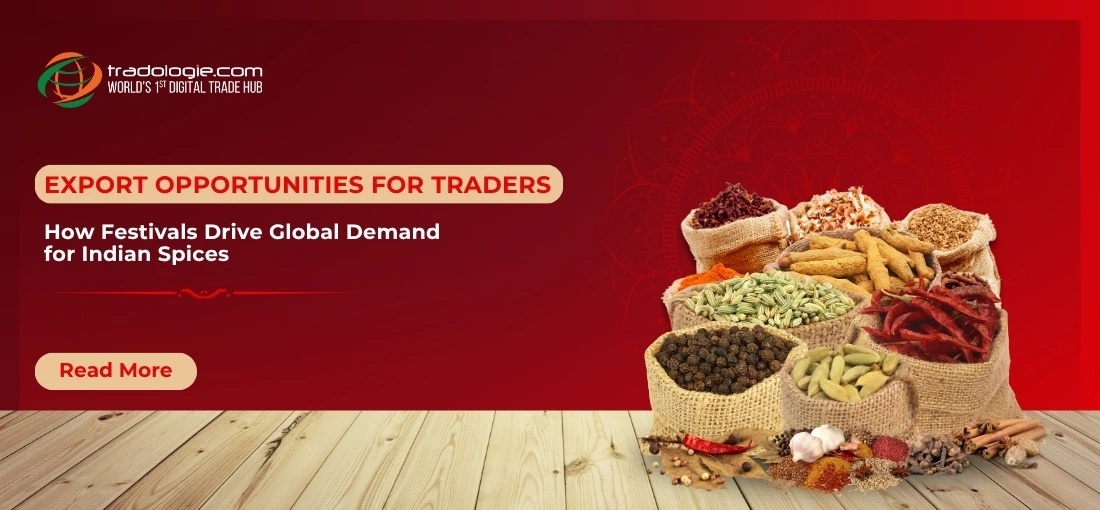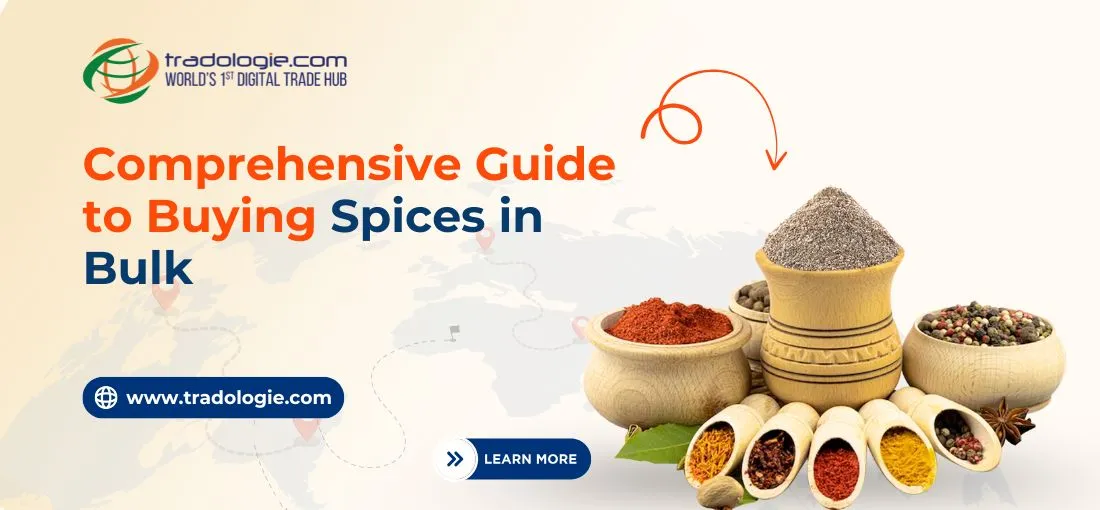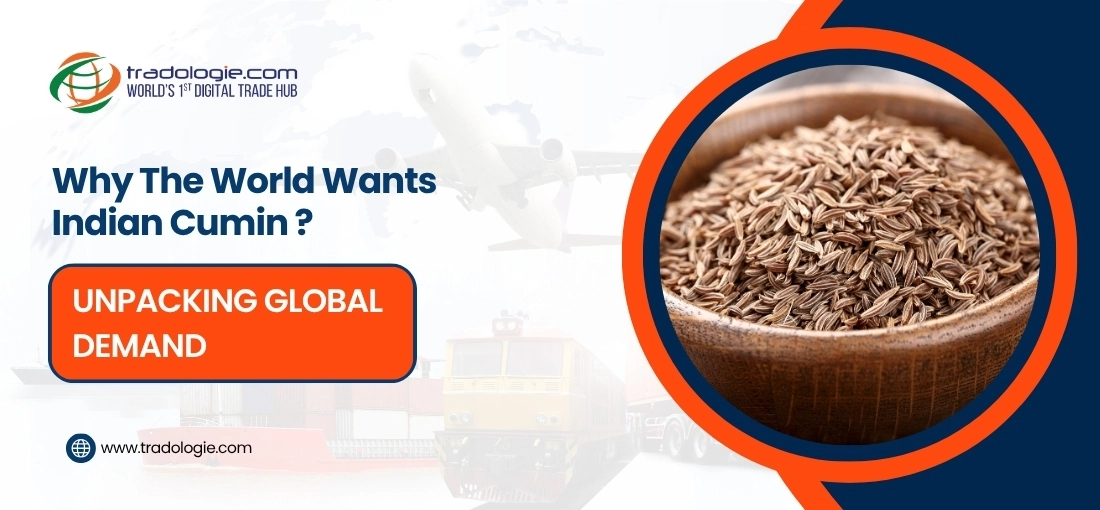How Festivals Drive Global Demand for Indian Spices - Export Opportunities for Traders
Key Highlights:
Global demand for pulses is rising in 2025, with chickpeas, lentils, dry beans, peas, and pigeon peas leading bulk trade.
- Export Peaks During Festivals : Big Indian festivals like Diwali, Holi, and Navratri create high global demand for spices, especially from NRIs who want authentic flavors for their celebrations.
- NRI Impact on Trade : Non-Resident Indians in countries such as the U.S., U.K., UAE, and Canada drive large bulk spice imports during festival seasons.
- Trusted Global Network : Tradologie connects spice traders directly with verified international buyers, helping ensure smooth deals and on-time delivery for festival-related exports.
- In-Demand Spices : Spices like cardamom, saffron, turmeric, cumin, and cinnamon see strong demand from diaspora communities and buyers worldwide.
- Strategic Advantages for Traders : Careful planning, using digital sourcing platforms, customizing products for specific markets, and following global quality standards help traders make the most of the festival export period.
Want to take advantage of the upcoming festive season with spice exports? India, the largest spice exporter in the world, supplies many markets across different continents. Festivals in India are not just cultural events—they also create big demand for spices. Traditional cooking, gifting, and special recipes lead to seasonal spikes in demand that reach beyond India.
From FY22 to FY24, India's B2B spice exports grew from $3.46 billion to $4.46 billion, showing year-on-year growth of 7.8% and 19.6%. Predictions suggest exports could reach $10 billion by 2030.
The Indian community abroad, especially NRIs, plays a key role in this global demand, looking for authentic spices for their celebrations. International festivals like Christmas and Thanksgiving also boost spice imports in major markets like the US and Europe.
For B2B traders, knowing these seasonal trends is important to make the most of export opportunities. Let's look at the main points.
The Cultural Significance of Spices During Indian Festivals
Spices from India have a long history of being traded worldwide. During festival seasons, spice use rises sharply, adding flavor to traditional meals, sweets, and drinks. Spices are valued not just for taste but also for their connection to health, luck, and prosperity. Here's how major festivals affect spice trade:
- Diwali (October-November) : Cardamom, saffron, and nutmeg are in high demand for sweets like 'mithai' and 'ladoos'. Indian families abroad, especially NRIs in the U.S., U.K., Canada, and UAE, also buy these spices to follow traditions.
- Holi (March) : Turmeric and cumin are needed for 'gujiya' and 'thandai'. NRIs often order these spices early to keep recipes authentic.
- Eid (dates vary) : Cinnamon, cloves, and coriander are used more for biryanis and kebabs. Bulk orders come from Middle Eastern and Southeast Asian markets.
- Navratri (September-October) : Special fasting foods increase demand for black pepper and ginger. Indian communities in Europe and North America import these spices to keep traditions alive.
- Christmas (December) : Cinnamon and nutmeg are important for baked goods and desserts, popular with NRIs and other international buyers.
These festivals boost domestic spice use and also strengthen India's exports, helping NRIs and global buyers continue traditional cooking. Festive seasons like Christmas and New Year further increase demand for spices and other agro-commodities.
India's Spice Export Landscape
India is the world leader in spice production and export. In the fiscal year 2024-25, India exported approximately 1.4 million metric tons of spices, valued at around $4.46 billion, marking a 6% increase from the previous year (Cybex).
Leading Spice-Producing StatesThe primary spice-producing states in India include:
- Madhya Pradesh : 3.63 million tonnes
- Gujarat : 1.29 million tonnes
- Andhra Pradesh : 1.28 million tonnes
- Rajasthan : 1.23 MT
- Telangana : Over 0.74 million tonnes each (PIB)
Key Spices in Demand During Festivals
Certain spices see heightened demand during festival seasons. Let's have a look at the most popular ones in demand globally.
- Cardamom: Essential for sweets and beverages
- Saffron: Used in biryanis and desserts
- Cumin and Coriander: Foundational in savory dishes
- Turmeric and Ginger: Integral to traditional preparations
- Cinnamon and Cloves: Common in baked goods and festive drinks
Traders who understand this NRI-driven demand can better anticipate international market needs.
Export Destinations and Market Dynamics
India exports spices to over 150 countries. Here's the list of top five major importers of spices from India, destinations Key markets include:
- United States : Leading in both value and volume, driven by the Indian community's festival preparations
- China : Major importer of red chilies
- Vietnam : Acts as a re-export hub for processed spices
- Middle Eastern Countries : High demand from Indian expatriates for authentic festival dishes.
- European Union : Rising interest in Indian spice blends and organic products (SpicesIndia)
Smart Export Tips for B2B Spice Traders
Festival seasons create big demand for Indian spices. Here's how traders can make the most of it:
- Prepare Early and Keep Stock Ready Have your spices ready before the festival rush. Strong connections with producers in top regions help meet demand on time, especially for NRIs and buyers abroad.
- Use Online B2B Platforms Platforms like Tradologie let exporters connect with verified global buyers quickly. With real-time pricing, smooth shipping, and a wide network of suppliers, trading becomes easier and more reliable.
- Match Products to Markets Different buyers want different spices. Middle Eastern NRIs prefer saffron and cinnamon, while North American buyers often look for cumin, turmeric, and cardamom for sweets and drinks. Offering the right spices for each market boosts sales and keeps buyers coming back.
- Keep International Quality Standards ISO-certified, organic, and residue-free products give buyers confidence. Maintaining high quality during busy festival times is key for repeat orders and keeping a strong global reputation.
Challenges and Considerations
Even with high demand, spice exporters need to focus on:
Quality Assurance : Make sure products meet global standards and satisfy NRI expectations.
Smooth Logistics : Deliver shipments on time to match festival schedules abroad.
Market Competition : Stand out by offering consistent quality, fair pricing, and good customer service.
NRIs are careful buyers who value authentic and high-quality spices, so it is important for traders to keep these standards consistently.
Conclusion
Festivals play a big role in the global popularity of Indian spices , and the Indian diaspora is key—they continue traditional cooking abroad and drive demand for exports during every festive season
For B2B spice traders , it is important to understand the cultural meaning of each festival, know harvest times, and follow diaspora buying patterns. The goal is to supply the right spices at the right time to the right buyers.
By using digital platforms, planning purchases early, and keeping high-quality standards, traders can succeed in the global spice market. This helps ensure growth while keeping NRIs and other overseas buyers happy with authentic Indian spices.



.webp)

